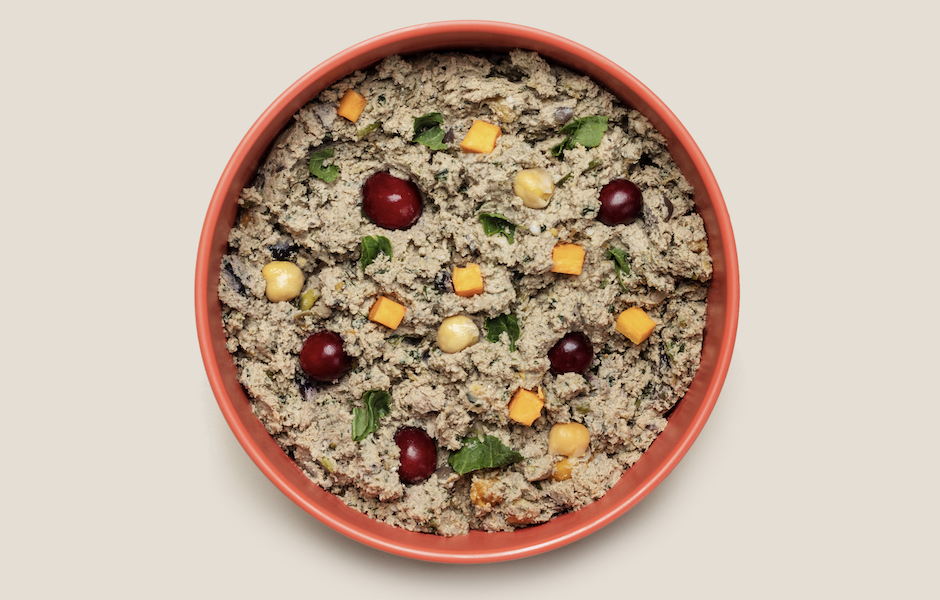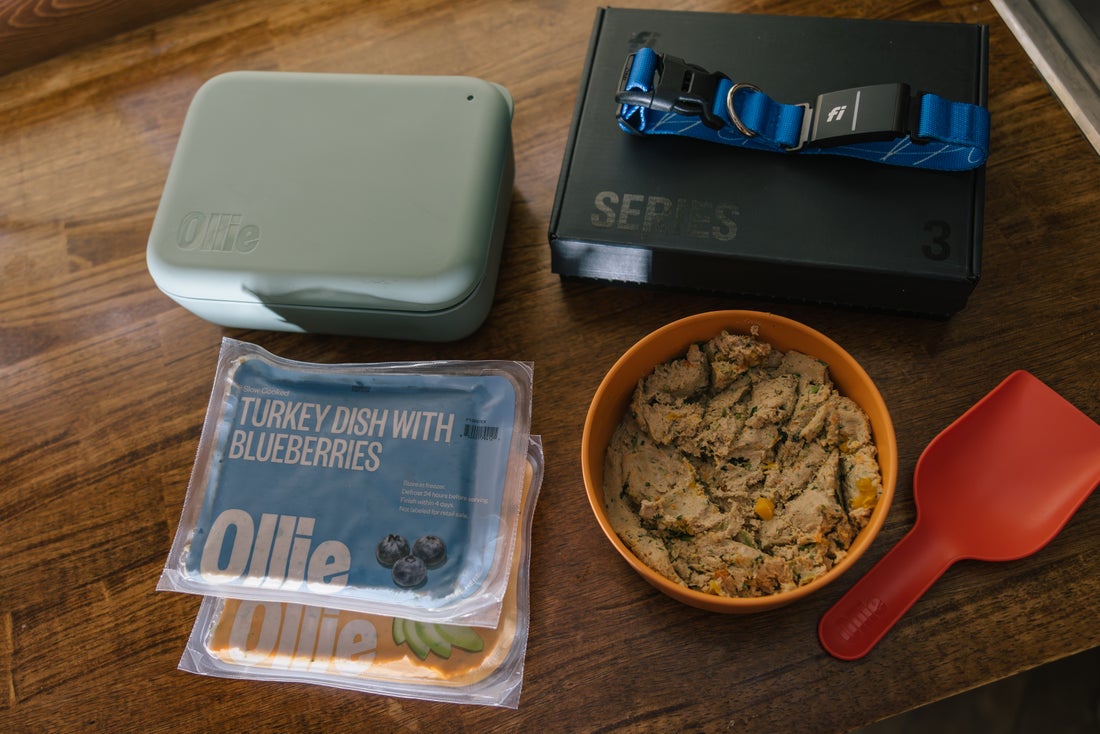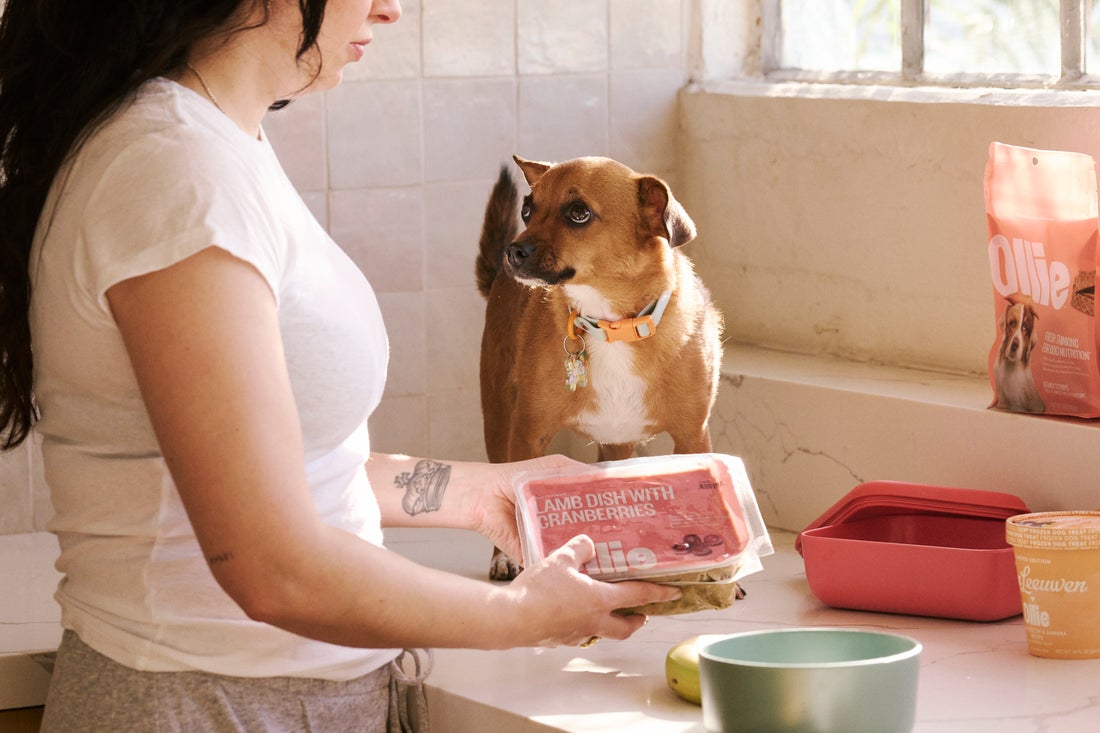Hey Ollie blog readers! We’re offering you an exclusive 60% OFF your starter box! Try now!
If your dog is throwing up white foam, your first reaction may be worry or fear. But there’s no reason to panic. In many cases dogs who occasionally vomit white foam are simply experiencing temporary digestive upset that can be addressed at home. But if your pup is throwing up repeatedly there may be cause for concern.
Here’s what you need to know about why dogs vomit white foam and how you can help your sick pup.
Why Is My Dog Vomiting White Foam?
Watching your dog throw up white foam can be unsettling—but in many cases, it’s not as serious as it looks. White, frothy vomit usually appears when a dog’s stomach is empty or slightly irritated. Instead of bringing up food, your dog expels a bubbly liquid made up of saliva and gastric acid.
This foamy vomit often shows up in the morning, after your dog hasn’t eaten for several hours, or after they’ve been active right after a meal. While it’s often harmless, white foam can also be a signal that your dog’s digestive system is a little off—or reacting to something they ate, inhaled, or experienced emotionally.
The key is knowing how often it happens and what other symptoms come with it. A single episode of vomiting white foam might not be a red flag, but if it happens more than once or your dog shows other signs of distress, it’s worth digging deeper.
When a dog vomits white foam or pale frothy vomit that looks similar to bubbly saliva (as opposed to chunkier dog vomit containing undigested food) it is often caused by your dog having an empty stomach. Your dog is most likely vomiting this white foam like liquid—typically a mix of saliva and gastric juices—because there’s little else in their stomach to purge.
What Actually Is The White Foam That Dogs Throw Up?
That white, frothy liquid your dog just expelled isn’t all that mysterious once you break it down. It’s mostly a mix of saliva, water, and stomach acids—all of which get aerated when your dog retches or coughs before vomiting.
The foamy texture comes from air being whipped into the digestive fluids. Think of it like shaking a bottle of soapy water—the bubbles aren’t from something harmful, but from agitation and air.
Pet experts commonly state that this “type of vomit often appears when a dog’s stomach is empty or slightly irritated”. It might be the first sign that your dog is feeling nauseous, even if they haven’t eaten anything unusual. Common triggers include light indigestion, anxiety, or eating grass and other non-food items while outside.
That said, white foam isn’t always a minor issue. In some cases, it can be a symptom of something more serious—like pancreatitis, kennel cough, or bloat—especially if it’s accompanied by lethargy, diarrhea, or a swollen abdomen.
What Causes a Dog to Throw Up White Foam?
Gastrointestinal (GI) distress is the most common reason why dogs vomit white foam. Foamy vomit may also occur if a dog has excess gas in their stomach, which can lead to abdominal discomfort and nausea. If your dog is experiencing indigestion and their stomach is empty, they may vomit this pale, frothy liquid or foam.
There can be several reasons why dogs throw up white foam, and not all of them point to illness or a serious condition such as kidney disease. Many causes are short-term and resolve on their own, but knowing the difference between a simple upset stomach and a true medical concern can make all the difference.
Here are some of the most common causes of white foam vomiting in dogs:
- Empty stomach: When there’s no food to absorb stomach acid, it can irritate the lining and cause vomiting.
- Eating grass or other non-food material: Grass blades can trigger mild nausea or stomach spasms.
- Stress or anxiety: Nervous dogs may experience “nervous tummy,” especially during travel, loud noises, or changes in routine.
- Exercise right after eating: Running, jumping, or playing on a full stomach can lead to foamy regurgitation.
- Motion sickness: Car rides and other forms of travel can unsettle the stomach, especially in puppies or anxious dogs.
- Mild GI irritation: This can happen from food sensitivities, sudden diet changes, or eating too fast.
If your dog throws up white foam once and seems fine afterward—eating normally, drinking water, acting like themselves—it’s usually nothing to worry about. But repeated episodes, or additional symptoms like diarrhea, fatigue, or bloating, mean it’s time to call your vet. All dog parents should seek veterinary assistance or visit an animal hospital if this become a frequent incident or if you suspect a more serious issues such as gastrointestinal issues, a foreign body stuck in the digestive system, or a connection to more serious health conditions.
Best Food for Dogs with Sensitive Stomachs
Can Vomiting White Foam Signal More Serious Problems?
In some cases, vomiting white foam can indicate a more serious underlying health problem, especially if it’s occurring frequently or accompanied by other illness signs such as coughing, difficulty breathing, lethargy, or tremors. Call your veterinarian if you are concerned by your pup’s behavior or clinical signs. Serious conditions associated with foamy, white vomit include:
- Kennel cough (canine infectious tracheobronchitis) — Kennel cough is a highly contagious respiratory disease. Vomiting will likely be accompanied by a strong cough and sneezing or a runny nose.
- Tracheal collapse — This condition, which primarily affects toy breeds, occurs when the tracheal rings that reinforce a dog’s windpipe begin to collapse. Affected dogs also develop a honking cough which may be worsened when walking on a collar and leash.
- Bloat — Also known as gastric dilation, bloat occurs when the stomach fills with air. If bloat occurs, your dog’s abdomen will appear distended. If the stomach twists, this condition is known as gastric dilation volvulus (GDV) and requires emergency surgery.
- Bacterial or fungal infection — Bacteria can enter your pup’s digestive tract through spoiled or contaminated food. Fungal sources include environmental yeast, which is often found in bird or bat droppings. Other clinical signs include diarrhea, shaking, and appetite loss.
- Acid reflux — Like humans, dogs can experience acid reflux when gastrointestinal fluid flows into the esophagus.
- Pancreatitis — Pancreatitis is a painful inflammatory condition that occurs when digestive enzymes leak from the pancreas and attack surrounding tissue. Acute pancreatitis in dogs can be triggered by dietary indiscretion (i.e., eating sugary, fatty, or spicy human food).
- Kidney injury or disease — When your dog’s kidneys aren’t functioning properly, they may exhibit extreme changes in thirst level, pale gums, and frothy vomit.
- Toxin ingestion — Vomiting is a common clinical sign for many pet toxins.
- Heat stroke — When dogs overheat, they experience rapid internal changes that lead to sickness (e.g., vomiting, lethargy), incoordination, and potentially fatal organ damage.
What to Do If Your Dog Is Throwing Up Blood
How to Treat a Dog Who’s Throwing Up White Foam
Immediately contact your veterinarian if your pup is experiencing any concerning signs. These situations require professional veterinary intervention. Do not attempt at-home treatment.
However, if you know your pup chowed down on some grass earlier and they’re otherwise behaving normally, it is probably safe to monitor them at home.
You may attempt to calm your pup’s irritated gut by withholding food for up to 12 hours. Offer ice cubes instead of water until their visible signs subside. When your dog is ready to eat again, offer a small amount of easily-digestible food such as boiled chicken and rice. If they tolerate the meal, gradually ease your pup back to their normal diet over the next 48 to 72 hours and watch for further vomiting.
Recover and Reset with Bland Diets for Dogs
Is Home Treatment Appropriate for a Dog Throwing Up White Foam?
Deciding between home treatment and seeking veterinary care depends on your dog’s overall condition and the circumstances surrounding the vomiting. While mild cases may resolve on their own, it’s crucial to approach the situation with caution, as white foam vomit can sometimes indicate a more serious health issue.
If your dog is alert, active, and otherwise behaving normally, you may choose to observe them closely for any changes in symptoms. Temporary digestive upset caused by an empty stomach, mild irritation, or a known non-toxic ingestion might not require immediate intervention. However, if your dog continues to vomit, seems lethargic, refuses to eat or drink, or exhibits additional symptoms such as abdominal pain or difficulty breathing, it’s best to err on the side of caution and consult your veterinarian.
Even if the initial signs seem minor, contacting a vet can provide peace of mind and ensure that any underlying conditions are addressed promptly. Vomiting white foam could point to issues like gastrointestinal irritation, exposure to harmful substances, or infections that might worsen without treatment. Timely professional advice is the best way to protect your dog’s health and prevent potential complications.
How to Prevent Persistent Vomiting in Dogs
Although initially it’s a relief to learn that your veterinarian can’t determine a medical cause for your pup’s persistent vomiting, it can also be frustrating. Fortunately, there are a few things you can try at home to minimize the mess and stop your pup from throwing up.
- Change your pup’s food — White foamy vomit may not contain any food, but that doesn’t mean your dog’s current diet isn’t upsetting their digestive system. Try rotating proteins or switching to a fresh food diet. Every Ollie recipe is gently cooked to preserve nutrients and increase digestibility.
- Keep a consistent feeding schedule — Delayed meals can upset your pup’s stomach, so feed in a timely manner to avoid pre-meal vomiting.
- Give a bedtime or morning snack — Feeding a small food portion before bedtime or immediately after waking up may help settle your pup’s stomach and reduce irritating acid buildup.
- Reduce stress and anxiety — Stress is a frequent but often overlooked precursor to vomiting in otherwise healthy pets. Observe your pup’s behavior and strive to minimize possible stressors. Exercise is a great way to decrease stress in pets and humans, so go ahead and take a nice long walk!
- Keep a journal — One way to identify potential patterns or triggers is to record your pup’s vomiting episodes on a calendar or in a journal. Make note of any other changes such as increased excitement (e.g., a neighbor came to visit), unusual foods or treats, or other events (e.g., your dog came in from playing and drank a lot of water) that preceded—and potentially triggered—their episode. Follow up with your veterinarian if you notice a pattern or potential cause.


Find Out Which Recipe Plan is Right for Your Dog’s Needs
Get 50% of your first box of Ollie’s fresh
delivered meals today!
When to See a Vet About White Foam Vomiting
Not every episode of white foam vomiting is an emergency, but there are times when it signals something more serious. Knowing when to pick up the phone can make all the difference.
You should contact your vet if:
- Your dog is vomiting white foam more than once in 24 hours
- Vomiting is accompanied by lethargy, weakness, or loss of appetite
- There are signs of abdominal swelling or pain
- The foam contains blood or appears unusually thick or discolored
- Your dog is also experiencing diarrhea or coughing
- You suspect your dog may have eaten something toxic or indigestible
Consistent vomiting—whether foamy or not—can lead to dehydration, electrolyte imbalances, and further stomach irritation if left untreated. In more severe cases, repeated white foam vomiting may point to pancreatitis, kennel cough, bloat, or a gastrointestinal obstruction, all of which require medical attention.
It’s always better to err on the side of caution. If your dog seems “off” in any way, or you’re just not sure whether to worry, a quick call to your vet can provide peace of mind—and possibly prevent a bigger issue.
Can Diet Help Prevent White Foam Vomiting?
Yes, in many cases, what your dog eats—and when they eat—can play a big role in preventing white foam vomiting. A stable, gut-friendly diet can help reduce acid buildup, support healthy digestion, and keep your dog’s stomach from getting too empty between meals.
Here’s how diet helps:
- Keeps the stomach satisfied: Feeding your dog twice a day (or more, depending on size and breed) can help prevent the “empty stomach” effect that often triggers white foam vomiting.
- Supports gut health: Fresh food made with simple, whole ingredients is easier to digest and less likely to cause irritation.
- Reduces inflammation: Many commercial kibbles contain fillers, by-products, or artificial additives that can lead to low-level inflammation and GI discomfort over time.
At Ollie, we’ve seen how real food can make a difference. Our gently cooked meals are made with high-quality proteins and digestive-friendly ingredients like pumpkin, carrots, and chia seeds—all chosen to support a healthy gut and reduce the risk of stomach upset.
If your dog is prone to vomiting on an empty stomach, switching to a fresh dog food diet with consistent feeding times may be the first step toward a calmer, more comfortable digestive system.
The Ollie blog is devoted to helping pet parents lead healthier lives with their pups. If you want to learn more about our fresh, human-grade food, check out MyOllie.com.
Tagged As:

The nutrition your dog needs,
the food they want.

Enjoying our articles? Subscribe our Newsletters and get new articles directly to your inbox
You might also like
18 September 2025
5 MINS READ
Can I Rotate Fresh Dog Food Flavors?
Yes, it’s safe to rotate fresh dog food flavors, and many dogs actually benefit from the variety. At Ollie, we offer multiple fresh recipes, like Beef, Chicken, Turkey, Lamb, and Pork so you can…
by Ollie Pets
18 September 2025
5 MINS READ
Is Fresh Dog Food Safe During Power Outages?
Fresh dog food is only safe during a power outage if it has stayed cold, specifically, below 40°F. Once the temperature rises above that point, bacteria can start to grow, and the food may no lon…
by Ollie Pets
18 September 2025
5 MINS READ
How Do I Store Fresh Dog Food While Traveling?
If you’re bringing fresh dog food on the road, keeping it cold is key. The best way to store it is in a cooler with ice packs or a travel freezer. At Ollie, our vacuum-sealed fresh food stays good…
by Ollie Pets







